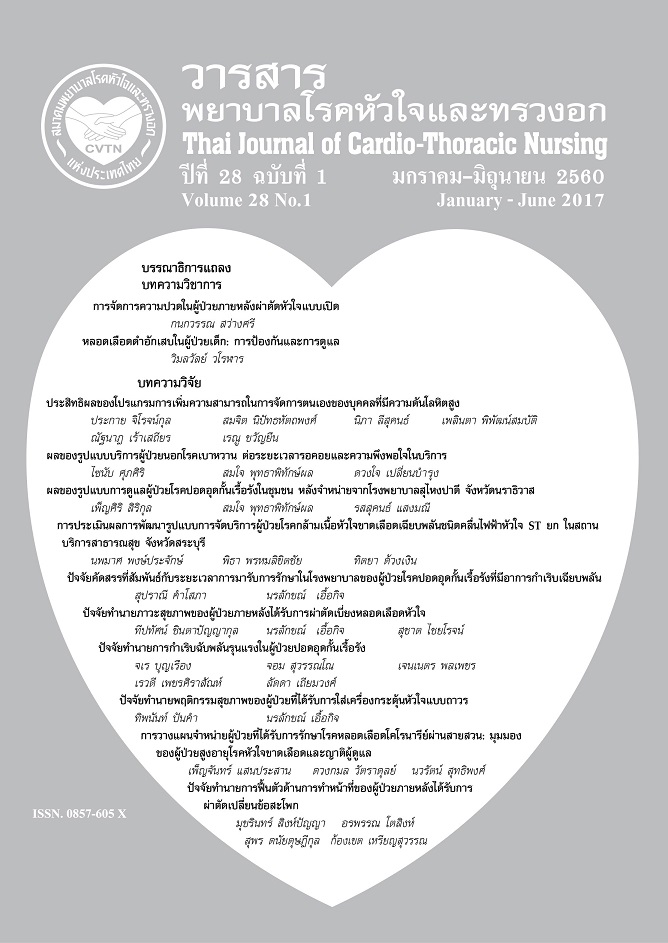ปัจจัยคัดสรรที่สัมพันธ์กับระยะเวลาการมารับการรักษาในโรงพยาบาลของผู้ป่วยโรคปอดอุดกั้นเรื้อรังที่มีอาการกำเริบเฉียบพลัน
Keywords:
ระยะเวลาการมารับการรักษา, ปัจจัยคัดสรร, โรคปอดอุดกั้นเรื้อรัง, pre-hospital time, selected factors, chronic obstructive pulmonary diseaseAbstract
การวิจัยเชิงสหสัมพันธ์นี้ มีวัตถุประสงค์เพื่อศึกษาระยะเวลาการมารับการรักษาของผู้ป่วยโรคปอดอุดกั้นเรื้อรังที่มีอาการกำเริบเฉียบพลัน และปัจจัยคัดสรรที่สัมพันธ์ ได้แก่ อาการหายใจลำบาก การรับรู้ความรุนแรงของโรค ความเหนื่อยล้า ความวิตกกังวลและการสนับสนุนทางสังคม กับระยะเวลาการมารับการรักษา กลุ่มตัวอย่างคือ ผู้ป่วยโรคปอดอุดกั้นเรื้อรังที่มีอาการกำเริบเฉียบพลัน จำนวน 123 คน ที่เข้ารับการรักษาในโรงพยาบาลตากสินและโรงพยาบาลกลาง เครื่องมือวิจัย คือ แบบสอบถามข้อมูลส่วนบุคคล แบบสอบถามระยะเวลาการมารับการรักษาของผู้ป่วยโรคปอดอุดกั้นเรื้อรัง แบบประเมินอาการหายใจลำบาก แบบประเมินการรับรู้ความรุนแรงของโรค แบบวัดความเหนื่อยล้า แบบประเมินความวิตกกังวล และแบบสอบถามความรู้สึกหลากหลายมิติเกี่ยวกับความช่วยเหลือทางสังคม วิเคราะห์ข้อมูลโดยใช้สถิติพรรณนา และค่าสัมประสิทธิ์สหสัมพันธ์ของเพียร์สัน
ผลการวิจัยพบว่า กลุ่มตัวอย่างส่วนใหญ่เป็นเพศชาย อายุระหว่าง 50 - 59 ปี คิดเป็นร้อยละ 84.6 (mean = 52.9, S.D. = 5.42) มีค่าเฉลี่ยของระยะเวลาการมารับการรักษา 60 นาที (S.D. = 38.70) ผลการวิเคราะห์ความสัมพันธ์ของตัวแปรพบว่า อาการหายใจลำบาก การรับรู้ความรุนแรงของโรค ความเหนื่อยล้า ความวิตกกังวลและการสนับสนุนทางสังคม มีความสัมพันธ์ทางลบกับระยะเวลาการมารับการรักษา อย่างมีนัยสำคัญทางสถิติ (p<.05) (r= -.730, -.699, -.217, -.333 และ -.429 ตามลำดับ)
ผลการวิจัยนี้สามารถนำไปประยุกต์ใช้ในการพัฒนาโปรแกรมส่งเสริมการรับรู้ความรุนแรงของอาการหายใจลำบาก ความรุนแรงของโรค และเพิ่มการสนับสนุนทางสังคมให้ผู้ป่วยโรคปอดอุดกั้นเรื้อรัง เพื่อให้ผู้ป่วยมีระยะเวลาการมารับการรักษาอย่างเหมาะสมเมื่อเกิดอาการกำเริบเฉียบพลัน
Selected factors related to pre-hospital time in chronic obstructive pulmonary disease patients with acute exacebation
The purpose of this descriptive correlational study were to describe the pre-hospital time for seeking treatment and to examine the relationships between dyspnea, perceived severity, fatigue, anxiety, social support, and pre – hospital time with chronic obstructive pulmonary disease patients with acute exacerbation. One hundred twenty three patients with chronic obstructive pulmonary disease with acute exacerbation at Taksin Hospital and Klang Hospital. Questionnaires were composed of demographic information, the assessment of pre – hospital time in patients with chronic obstructive pulmonary disease, the assessment of dyspnea, perceived severity of disease, Multidimensional Fatigue Inventory (MFI-20), the assessment of anxiety, and the Multi-dimensional Scale of Perceived Social Support (r-T-MSPSS). Descriptive statistics, and Pearson’s Product Moment Correlation were used to analyze data.
The results showed that more than half (84.6%) of subjects were males with the age between 50 and 59 years. (mean = 52.9, S.D. = 5.42). Mean scores of the pre-hospital time was 60 minutes. (S.D. = 38.70). There were significantly negative relationships between dyspnea, perceived severity, fatigue, anxiety, social support, and pre – hospital time in chronic obstructive pulmonary disease patients with acute exacerbation (p<.05). ( r = -.730, -.699, -.217, -.333 and -.429 respectively)
These findings would be applied to develop program to raise the patients’ perception of the severity of dyspnea and disease, and to increase their social support so that they will have an appropriate pre-hospital time when they have acute exacerbation.
Downloads
How to Cite
Issue
Section
License
บทความนี้ยังไม่เคยตีพิมพ์หรืออยู่ในระหว่างส่งไปตีพิมพ์ในวารสารอื่น ๆ มาก่อน และกองบรรณาธิการขอสงวนสิทธิ์ในการตรวจทาน และแก้ไขต้นฉบับตามเกณฑ์ของวารสาร ในกรณีที่เรื่องของท่านได้ได้รับการตีพิมพ์ในวารสารฉบับนี้ถือว่าเป็น ลิขสิทธิ์ของวารสารพยาบาลโรคหัวใจและทรวงอก






